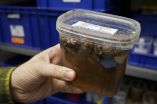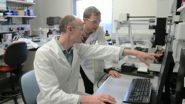All the world's oceans have plastic debris on their surface
Researchers have demonstrated the existence of five large accumulations of plastic waste in the open ocean, which match with the five major twists of surface water circulation
2014-07-01
(Press-News.org) However, central surface waters of the oceans may not be the final destination of plastic debris since, as indicated by the study performed by the Malaspina Expedition, large amounts of microplastics could be passing to the marine food chain and the ocean floor. Results of the study, led by the University of Cadiz (Spain), have been published in the journal Proceedings of the National Academy of Sciences (PNAS).
Andrés Cózar, researcher from the University of Cadiz, explains: "Ocean currents carry plastic objects which split into smaller and smaller fragments due to solar radiation. Those little pieces of plastic, known as microplastics, can last hundreds of years and were detected in 88% of the ocean surface sampled during the Malaspina Expedition 2010".
According to the study authors, the results obtained by the Malaspina Expedition show that the problem of plastic waste pollution has a global character. The major residues found are polyethylene and polypropylene, polymers used in the manufacture of everyday products like bags, food and beverage containers, kitchen utensils and toys, among others.
Cózar adds: "These microplastics have an influence on the behavior and the food chain of marine organisms. On one hand, the tiny plastic fragments often accumulate contaminants that, if swallowed, can be passed to organisms during digestion; without forgetting the gastrointestinal obstructions, which are another of the most common problems with this type of waste. On the other hand, the abundance of floating plastic fragments allows many small organisms to sail on them and colonize places they could not access to previously. But probably, most of the impacts taking place due to plastic pollution in the oceans are not yet known".
CSIC researcher Carlos Duarte, coordinator of the Malaspina Expedition, states: "Our results show that the high concentration of plastic is not a unique feature of the Nort Pacific, but occurs in each of the subtropical gyres". Duarte concludes: "Only a global expedition, such as the Malaspina Expedition, could achieve these results and evaluate the overall abundance of plastic pollution. The good news is that abundance is much lower than expected, but the pending challenge is to figure out where the rest of plastics entering the ocean is".
The Malaspina Expedition
The Malaspina Circumnavigation Expedition 2010, a project led by CSIC that includes more than 400 researchers from around the world, started in December 15th 2010 with the departure of the Hespérides oceanographic research vessel from the port of Cadiz. On board of this ship belonging to the Spanish Armada, and the Sarmiento de Gamboa ship belonging to the CSIC, researchers studied for nine months (seven aboard the Hespérides and two aboard the Sarmiento) the impact of the global change on the ocean ecosystem and explored its biodiversity.
Scientists took nearly 200,000 water, plankton, atmosphere particles and gases samples in 313 points of the Indian, Pacific and Atlantic Oceans at depths of up to 6,000 meters. On board, they measured the temperature and salinity, the surface properties, the acoustics of the marine currents, the concentration of oxygen and carbon dioxide in the ocean and in the atmosphere, and the scope of the sunlight, among other parameters.
INFORMATION:
Andrés Cózar, Fidel Echevarría, Juan I. González-Gordillo, Xabier Irigoien, Bárbara Úbeda, Santiago Hernández-León, Álvaro Palma, Sandra Navarro, Juan García-de-Lomas, Andrea Ruiz, María L. Fernández-de-Puelles, and Carlos M. Duarte. Plastic debris in the open ocean. PNAS. DOI: 10.1073/pnas.1314705111
ELSE PRESS RELEASES FROM THIS DATE:
Genetic evidence that body mass increases the risk of asthma in mid-childhood
2014-07-01
Some of the increase in asthma risk toward the end of the 20th century could be attributed to the increase in body mass index (BMI) in mid-childhood, according to new research published in this week's PLOS Medicine. The study, led by Raquel Granell from the University of Bristol, UK, and colleagues, provides genetic evidence that higher fat mass and lean mass increase the risk of asthma in mid-childhood.
The incidence of asthma, a chronic condition caused by inflammation of the airways, has been rising steadily over the past few decades, and it is estimated that 200� ...
Cesarean section linked to slight increase in future stillbirth and ectopic pregnancy
2014-07-01
Caesarean section is associated with a slightly increased rate of subsequent stillbirth and ectopic pregnancy, according to a large study of women living in Demark, published in this week in PLOS Medicine. Given the global increase in Caesarean rates, the results of the study, which was conducted by Louise Kenny and colleagues from University College Cork, Ireland and Aarhus University, Denmark, are of interest to pregnant women, their partners, and healthcare providers.
The researchers obtained data for 832,996 women from Danish national registers regarding their first ...
Catheter ablation a first-line treatment for atrial flutter
2014-07-01
Use of catheter ablation is not only beneficial for treating atrial flutter but also can significantly reduce hospital visits – both inpatient and emergency – and lower the risk for atrial fibrillation, according to research by UC San Francisco.
The study is in the July issue of PLOS ONE and available online.
"We've seen firsthand in our clinical experience that atrial flutter is difficult to control with drugs, even more than atrial fibrillation," said senior author Gregory Marcus, MD, director of clinical research in the UCSF Division of Cardiology. "Based on our ...
New insights from the modENCODE Project are published in Genome Research
2014-07-01
July 1, 2014 – Genome Research publishes six articles online and in print today describing recent advancements from the modENCODE Project. Initially launched in 2007, the goal of the modENCODE Project is to comprehensively characterize functional genomic elements in two model organisms, the fly Drosophila melanogaster, and the worm Caenorhabditis elegans. Comparative analyses in these well-established systems are expected to guide efforts to further our understanding of human biology. The articles published in this issue present new genomic advances shedding light upon ...
New compound blocks 'gatekeeper' enzyme to kill malaria
2014-07-01
VIDEO:
Melbourne researchers are homing in on a new target for malaria treatment, after developing a compound that blocks the action of a key 'gatekeeper' enzyme essential for malaria parasite survival.
The...
Click here for more information.
Melbourne researchers are homing in on a new target for malaria treatment, after developing a compound that blocks the action of a key 'gatekeeper' enzyme essential for malaria parasite survival.
The compound, called WEHI-916, is ...
Analysis of the Chinese facial profile: Contours of the side face in the Tu and Zang ethnic minorities
2014-07-01
Li Haijun and fellow researchers at Minzu University of China, in Beijing, conducted a series of geometric morphometric analyses of the contours of the side face and variations in the Tu and Zang (Tibetan) ethnic minorities from Qinghai Province, in northwestern China.
Their study, entitled "Morphometric analysis of the Chinese facial profile: Contours of the side face and variations in the Tu and Zang ethnic minorities", was published (in Chinese) in the Chinese Science Bulletin, 2014, Vol 59(16).
The team of researchers used advanced digital cameras and image processing ...
Behind a marine creature's bright green fluorescent glow
2014-07-01
Pushing closer to understanding the mechanisms behind the mysterious glow of light produced naturally by certain animals, scientists at Scripps Institution of Oceanography at UC San Diego have deciphered the structural components related to fluorescence brightness in a primitive sea creature.
In a study published in Scientific Reports, an open-access journal of the Nature Publishing Group, Dimitri Deheyn and his colleagues at Scripps Oceanography, the Air Force Research Laboratory, and the Salk Institute for Biological Studies have conducted the most detailed examination ...
Solar panels light the way from carbon dioxide to fuel
2014-07-01
Research to curb global warming caused by rising levels of atmospheric greenhouse gases, such as carbon dioxide, usually involves three areas: Developing alternative energy sources, capturing and storing greenhouse gases, and repurposing excess greenhouse gases. Drawing on two of these approaches, researchers in the laboratory of Andrew Bocarsly, a Princeton professor of chemistry, collaborated with start-up company Liquid Light Inc. of Monmouth Junction, N.J. to devise an efficient method for harnessing sunlight to convert carbon dioxide into a potential alternative fuel ...
Poor physical, financial health driven by same factors
2014-07-01
Poor physical health and financial health are driven by the same underlying psychological factors, finds a new study out of the Olin Business School at Washington University in St. Louis.
Researchers Lamar Pierce, PhD, associate professor of strategy at Olin and PhD-candidate Timothy Gubler found that the decision to contribute to a 401(k) retirement plan predicted whether or not an individual will act to correct poor physical health indicators revealed during an employer-sponsored health examination.
"We find that existing retirement contribution patterns and future ...
Blind lead the way in brave new world of tactile technology
2014-07-01
Imagine feeling a slimy jellyfish, a prickly cactus or map directions on your iPad mini Retina display, because that's where tactile technology is headed. But you'll need more than just an index finger to feel your way around.
New research at UC Berkeley has found that people are better and faster at navigating tactile technology when using both hands and several fingers. Moreover, blind people in the study outmaneuvered their sighted counterparts – especially when using both hands and several fingers – possibly because they've developed superior cognitive strategies ...
LAST 30 PRESS RELEASES:
Norbert Holtkamp appointed director of Fermi National Accelerator Laboratory
New agentic AI platform accelerates advanced optics design
Biologists discover neurons use physical signals — not electricity — to stabilize communication
Researchers discover that a hormone can access the brain by hitchhiking
University of Oklahoma researcher awarded funding to pursue AI-powered material design
Exploring how the visual system recovers following injury
Support for parents with infants at pediatric check-ups leads to better reading and math skills in elementary school
Kids’ behavioral health is a growing share of family health costs
Day & night: Cancer disrupts the brain’s natural rhythm
COVID-19 vaccination significantly reduces risk to pregnant women and baby
The role of vaccination in maternal and perinatal outcomes associated with COVID-19 in pregnancy
Mayo Clinic smartwatch system helps parents shorten and defuse children's severe tantrums early
Behavioral health spending spikes to 40% of all children’s health expenditures, nearly doubling in a decade
Digital cognitive behavioral treatment for generalized anxiety disorder
Expenditures for pediatric behavioral health care over time and estimated family financial burden
Air conditioning in nursing homes and mortality during extreme heat
The Alps to lose a record number of glaciers in the next decade
What makes a good proton conductor?
New science reporting guide published for journalists in Bulgaria
New international study reveals major survival gaps among children with cancer
New science reporting guide published for journalists in Turkey
Scientists develop a smarter mRNA therapy that knows which cells to target
Neuroanatomy-informed brain–machine hybrid intelligence for robust acoustic target detection
Eight SwRI hydrogen projects funded by ENERGYWERX
The Lundquist Institute and its start-up company Vitalex Biosciences Announces Strategic Advancement of Second-Generation fungal Vaccine VXV-01 through Phase 1 Trials under $40 Million Competitive Con
Fine particles in pollution are associated with early signs of autoimmune disease
Review article | Towards a Global Ground-Based Earth Observatory (GGBEO): Leveraging existing systems and networks
Penn and UMich create world’s smallest programmable, autonomous robots
Cleveland researchers launch first major study to address ‘hidden performance killer’ in athletes
To connect across politics, try saying what you oppose
[Press-News.org] All the world's oceans have plastic debris on their surfaceResearchers have demonstrated the existence of five large accumulations of plastic waste in the open ocean, which match with the five major twists of surface water circulation



